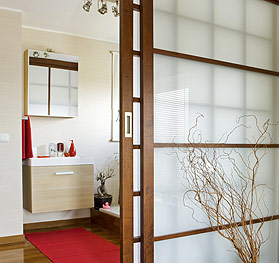Pocket doors were popular in the Victorian era, but gradually fell out of favor due to mechanical issues and changing tastes. Now, thanks to hardware improvements and modern designs, pocket doors are seeing a resurgence in popularity, especially as people look for ways to maximize space in their homes.
Pocket doors hang from rollers suspended from an overhead track. The door slides into a compartment build into the adjacent wall when opened. Pocket doors are a great solution for those looking to save some space. You can save an average of 10 square feet of floor space for each pocket door you use in place of a hinged door. Pocket doors are ideal for compact spaces, such as closets, bathrooms, home offices, pantries, and laundry rooms. Pocket doors can also improve quality of life for those with mobility impairments that make maneuvering around a swinging door difficult.
Pocket doors offer a clean, open look. When fully opened, pocket doors are virtually invisible. They’re also a great design element that is often overlooked. Today’s pocket doors have evolved and offer a range of stylish and elegant architectural designs. Choose from plank doors, flat or raised panel doors, doors with glass inserts, and more. You can also use double pocket doors as French doors to add a touch of sophistication to a wider doorway. Imagine using double French doors with frosted glass inserts as a beautiful separation between your living room and dining area. A pocket door with clear glass is perfect for a home office, providing privacy and quiet while still allowing in light and letting you to see what’s going on outside of your office. A mirrored pocket door for your closet provides you with an instant full-length mirror when closed.
A common complaint of pocket doors in the past was issues with the hardware that allowed the doors to come off the tracks inside the wall compartment, necessitating difficult repairs. Today’s pocket doors use solid steel runners and rollers made of hard nylon material that allow them to operate much more reliably and smoothly. They also tend to be much quieter than the older pocket doors.
Pocket doors can be installed easily during construction or renovation. You can also install them in an existing house, but it will require more effort and will cost more. Installation in an existing home will require the removal of some drywall to get into the wall cavity. You will also need to be aware of any electrical wires, plumbing lines, pipes, or heating and cooling ducts that may reside in the wall. In many cases these components can be relocated, but it will increase your costs. If you decide to install a pocket door yourself, McCray Lumber and Millworks highly recommends that you use a pocket door kit, which includes all of the necessary materials, rather than buying all the components individually.


